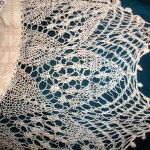
Our Eastern European Threads series brings you information and tips about Balkan and other Eastern European textiles and costumes. In this issue, knitted lace edging on a chemise from Kjustendil, Bulgaria.
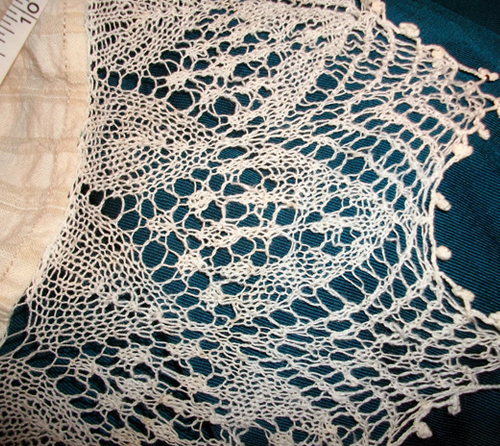
Lace edging on a chemise from Kjustendil, Bulgaria, part of a costume purchased in 2001 in Missouri from the granddaughter of the original owner.
One of the things I find fascinating about clothing in general and folk costumes in particular is the urge to decorate the edges, to complete them.
I bring to your attention the edge of a sleeve finished with lace—something that, if worn by me, would probably get dragged accidentally through food on my plate, paperwork on the desk or possibly snagged on a chair back. Yet this sleeve has lace. And not just a skimpy row of machine-made, sturdy, store-bought lace, but a lavish flaring sweep of handmade froth. The lace starts out at as a mere 24-inch circle at the sleeve cuff and increases to almost 36 inches. The patterning makes the lace have points, so the depth of the lace varies from 2 1/2 to 5 inches.
I’m going to go out on a limb and assume a woman made this lace—choosing to take the time to create something. This lace is knitted. For knitters, I’ll add that it was done in a 2-ply thread of either cotton or linen, in size 30, at a gauge of around 9–10 stitches per inch. What this means to non-knitters is the lace is fine and would have taken at least several days to complete. The older chemises I have seen are decorated with needle lace (created with a sewing needle) and, possibly because needle lace is a slower technique, these edges tend to be much narrower. I have such an example where the needle lace is only about 2 to 2 1/2 inches wide.
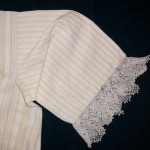
Another view of the same lace, showing more of the chemise.
I always joke that any type of decoration found on an everyday object is due to long winters, but of course, it could be that the individual who created the lace had fewer disposable items, fewer pieces of clothing—and that this chemise is from a time when wearing folk costume was a special versus an everyday occurrence. Or, it could just be if its creator wanted to make something special.
So, I think I’ll go off and make something special for myself.
Knitting Instructions for Kjustendil Chemise Lace
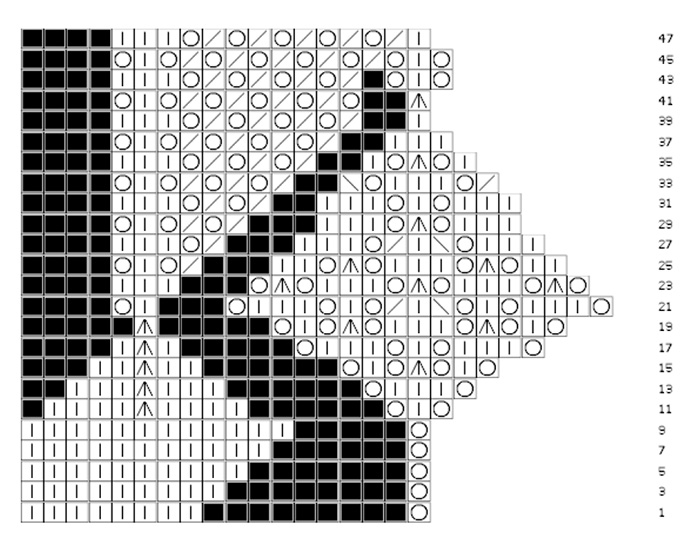
CO multiple of 8 and join in round. Even rows 2 through 44 are knit. Do not work a row 48, i.e. stop with row 47.
1: yo, k8 around
3: yo, k9 around
5: yo, k10 around
7: yo, k11 around
9: yo, k12 around
11: yo, k, yo, k4, s2kp, k4 around
13: yo, k3, yo, k3, s2kp, k3 around
15: yo, k, yo, s2kp, yo, k, yo, k2, s2kp, k2, etc.
17: yo, k3, yo, k, yo, k3, yo, k, s2kp, k
19: yo, k, yo, s2kp, yo, k3, yo, s2kp, yo, k, yo, s2kp
21: yo, k3, yo, k, yo, ssk, k, k2tog, yo, k, yo, k3, yo, k, yo
23: yo, s2kp, yo, k3, yo, s2kp, yo, k3, yo, s2kp, yo, k3
25: k2, yo, s2kp, yo, k3, yo, s2kp, yo, k2, k2tog, yo, k, yo
27: k3, yo, ssk, k, k2tog, yo, k3, k2tog, yo, k3
29: k3, yo, s2kp, yo, k3, k2tog, yo, k2tog, yo, k, yo
31: k3, yo, k, yo, k3, k2tog, yo, k2tog, yo, k3
33: k2tog, yo, k3, yo, ssk, k2tog, yo, (k2tog,yo) 2x, yo, k, yo
35: k, yo, s2kp, yo, k, (k2tog, yo) 3x, k3
37: k3, (k2tog, yo) 4x, k, yo
39: k, (k2tog, yo) 4x, k3
41: s2kp, (yo, k2tog) 4x, yo, k, yo
43: yo, k, yo, (k2tog, yo) 4x, k3
45: yo, k, yo, (k2tog, yo) 5x, k, yo
47: k, (k2tog, yo) 5x, k3
Crochet finishing: ch 7, *(ch 6, sl st in first for picot)) 3x, ch 6, sc in k2tog*; repeat around. When encountering the 3 consecutive knit stitches, single crochet them TOGETHER; when reaching the k2tog, k1, k2tog each stitch should receive a single crochet and 3 picot section.
Download Knitting Instructions for Kyustendil Chemise Lace (PDF).

Wendi Kiss first encountered Eastern European music, dance and costume quite some time ago and has never looked back. A former AVAZ member and group costume director, and one of the early members of Zhena Women’s Choir, she is currently a member and costume director of Planina Songs of Eastern Europe, Storm Mountain Folk Dancers (retired, but still costume director) and the Loveland Choral Society.
Wendi is editor of Kef Times’ Eastern European Threads. If you have an idea for an interesting textile, costume, costume tradition, etc., to be featured in a future issue, please contact her.
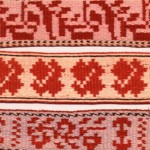

 first encountered Eastern European music, dance and costume quite some time ago and has never looked back. A former AVAZ member and group costume director, and one of the early members of Zhena Women's Choir, she is currently a member and costume director of Planina Songs of Eastern Europe, Storm Mountain Folk Dancers (retired, but still costume director) and the Loveland Choral Society.
first encountered Eastern European music, dance and costume quite some time ago and has never looked back. A former AVAZ member and group costume director, and one of the early members of Zhena Women's Choir, she is currently a member and costume director of Planina Songs of Eastern Europe, Storm Mountain Folk Dancers (retired, but still costume director) and the Loveland Choral Society.